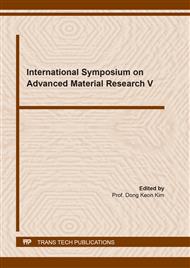[1]
J.A. Gorman, 7 - Corrosion problems affecting steam generator tubes in commercial water-cooled nuclear power plants, Steam Generators for Nuclear Power Plants, Elsevier Ltd., Amsterdam, 2017, pp.155-181.
DOI: 10.1016/b978-0-08-100894-2.00009-1
Google Scholar
[2]
M. Roche, C. Grenet, M. Richez, 5 - Troubleshooting corrosion problems in HF alkylation units, Corrosion in Refineries, European Federation of Corrosion (EFC) Series, 2007, pp.64-72.
DOI: 10.1533/9781845693244.64
Google Scholar
[3]
R.W. Revie, H.H. Uhlig, Corrosion and Corrosion Control; an Introduction to Corrosion Science and Engineering (fourth ed.), John Wiley & Sons Inc., Hoboken, New Jersey, (2008).
Google Scholar
[4]
E. McCafferty, Introduction to Corrosion Science, Springer Science+Bussiness Media, LLC, New York, (2010).
Google Scholar
[5]
J.R. Davis, Corrosion of Aluminum and Aluminum Alloys, ASM International, (1999).
Google Scholar
[6]
W.S. Tait, in Handbook of Environmental Degradation of Materials (Second Editi2nd Ed.), Elsevier Inc., Amsterdam, 2013. https://doi.org/10.1016/C2010-0-66227-4.
Google Scholar
[7]
Z. Ahmad, Principles of Corrosion Engineering and Corrosion Control, Elsevier Science and Technology Books, (2006).
Google Scholar
[8]
K. Xhanari, M. Finšgar, Organic corrosion inhibitors for aluminum and its alloys in chloride and alkaline solutions: A review. Arabian Journal of Chemistry, 12(8) (2019) 4646-4663. https://doi.org/10.1016/j.arabjc.2016.08.009.
DOI: 10.1016/j.arabjc.2016.08.009
Google Scholar
[9]
V. Branzoi, F. Golgovici, F. Branzoi, Aluminium corrosion in hydrochloric acid solutions and the effect of some organic inhibitors. Mats. Chem. Phys. 78(1) (2003) 122-131.
DOI: 10.1016/s0254-0584(02)00222-5
Google Scholar
[10]
T. Hu, H. Shi, T. Wei, F. Liu, S. Fan, E. Hana, Cerium tartrate as a corrosion inhibitor for AA 2024–T3, Corros. Sci. 95 (2015) 152-161.
DOI: 10.1016/j.corsci.2015.03.010
Google Scholar
[11]
E-S.M. Sherif, Effects of 3-amino-1,2,4-triazole-5-thiol on the inhibition of pure aluminum corrosion in aerated stagnant 3.5 wt.% NaCl solution as a corrosion inhibitor, Int. J. Elect. Sci. 7 (6) (2012) 4847-4859.
Google Scholar
[12]
R. Catubig, A.E. Hughes, I.S. Cole, B.R.W. Hinton, M. Forsyth, The use of cerium and praseodymium mercaptoacetate as thiol-containing inhibitors for AA2024-T3, Corros. Sci. 81 (2014) 45-53.
DOI: 10.1016/j.corsci.2013.12.001
Google Scholar
[13]
S. Zor, S. Saǧdinç, Experimental and theoretical study of sulfathiazole as environmentally friendly inhibitor on aluminum corrosion in NaCl, Prot. Met. Phys. Chem+. 50(2) (2014) 244-253.
DOI: 10.1134/s207020511402018x
Google Scholar
[14]
N.V. Lakshmi, N. Arivazhagan, S. Karthikeyan, The corrosion inhibition of aluminium in 3.5% NaCl by diisopropyl thiourea, Int. J. Chemtech Res. 5(4) (2013) 1959-1963.
Google Scholar
[15]
D. Snihirova, S.V. Lamaka, P. Taheri, J.M.C. Mol, M.F. Montemor, Comparison of the synergistic effects of inhibitor mixtures tailored for enhanced corrosion protection of bare and coated AA2024-T3, Surf. Coat. Technol. 303(B) (2016) 342-351.
DOI: 10.1016/j.surfcoat.2015.10.075
Google Scholar
[16]
R.T. Loto, C.A. Loto, Effect of P-phenylediamine on the corrosion of austenitic stainless steel type 304 in hydrochloric acid, Int. J. Elect. Sci. 7(10) (2012) 9423-9440.
DOI: 10.1007/s12633-015-9344-1
Google Scholar
[17]
R.T. Loto, Anti-corrosion performance of the synergistic properties of benzenecarbonitrile and 5-bromovanillin on 1018 carbon steel in HCl environment, Sci. Reps. 7(1) (2017) 17555.
DOI: 10.1038/s41598-017-17867-0
Google Scholar
[18]
C.A. Loto, R.T. Loto, A.P.I. Popoola, Effect of neem leaf (azadirachita indica) extract on the corrosion inhibition of mild steel in dilute acids, Int. J. Phy. Sci. 6(9) (2011) 2249-2257.
DOI: 10.17159/0379-4350/2015/v68a16
Google Scholar
[19]
T. Kahl, T., K-W. Schröder, F.R. Lawrence, F.R., W.J. Marshall, H. Höke, R. Jäckh Aniline" in Ullmann,s Encyclopedia of Industrial Chemistry, John Wiley & Sons, New York, (1977).
DOI: 10.1002/14356007.a02_303
Google Scholar
[20]
F.S. De Souza, R.S. Gonçalves, A. Spinelli, Assessment of caffeine adsorption onto mild steel surface as an eco-friendly corrosion inhibitor. Journal of Brazilian Chemical Society, 25(1) (2014). https://doi.org/10.5935/0103-5053.20130270.
DOI: 10.5935/0103-5053.20130270
Google Scholar
[21]
J. Zeldowitsch, Adsorption site energy distribution, Acta Physicochimica U.R.S.S., 1 (1934) 961–973.
Google Scholar
[22]
C. Aharoni, M. Ungarish, Kinetics of activated chemisorption. Part 2. Theoretical models, J. Chem. Soc. Faraday Trans. 73 (1977) 456–464.
DOI: 10.1039/f19777300456
Google Scholar
[23]
R.T. Loto, R. Leramo, B. Oyebade, Synergistic Combination Effect of Salvia officinalis and Lavandula officinalis on the corrosion inhibition of low-carbon steel in the presence of SO4 2−- and Cl−-containing aqueous environment, J. Fail. Anal. Prev. 18(6) (2018) 1429-1438.
DOI: 10.1007/s11668-018-0535-0
Google Scholar
[24]
R.T. Loto, O. Tobilola, Corrosion inhibition properties of the synergistic effect of 4-hydroxy-3-methoxybenzaldehyde and hexadecyltrimethylammoniumbromide on mild steel in dilute acid solutions, J. King Saud Univ. Eng. Sci. 30(4) (2018) 384-390.
DOI: 10.1016/j.jksues.2016.10.001
Google Scholar


